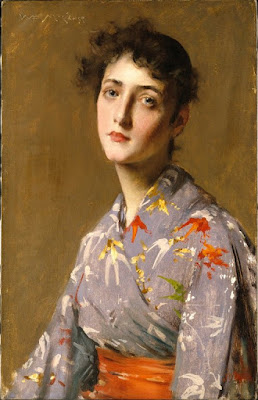

 There are plenty of brain hemispheres predominances tests at the WWW. What I like of this one is the animation. I wonder if it was a male I would see it clockwise, anti-clockwise or both.
There are plenty of brain hemispheres predominances tests at the WWW. What I like of this one is the animation. I wonder if it was a male I would see it clockwise, anti-clockwise or both.
What I could not help noticing is that when I look at the hand of the lower arm she is clockwise and if I focus at the arm that is up she is anti-clockwise.
 "Founded in 1993, Qcc is a multiracial community-building organization that fosters the artistic, economic and cultural development of San Francisco's LGBT community. We implement our mission by operating programs that commission and present Queer artists, that promote the development of culturally diverse Queer arts organizations and that document significant Queer arts events taking place in San Francisco."
This is a great initiative and I'm amazed by the way gay culture finds different ways to fight for their rights. There is still lots of prejudice, stigma and misunderstanding and some people still consider homosexuality as a disease.
We cannot forget that homosexuality was considered a mental disease till 1973.
Visit the site of the Queer Cultural Center.
Click at the picture that depicts the Hal Fischer's Gay Semiotics, 1977, and understand the meaning of handkerchief blue or red placed on the right or left and more.
"Founded in 1993, Qcc is a multiracial community-building organization that fosters the artistic, economic and cultural development of San Francisco's LGBT community. We implement our mission by operating programs that commission and present Queer artists, that promote the development of culturally diverse Queer arts organizations and that document significant Queer arts events taking place in San Francisco."
This is a great initiative and I'm amazed by the way gay culture finds different ways to fight for their rights. There is still lots of prejudice, stigma and misunderstanding and some people still consider homosexuality as a disease.
We cannot forget that homosexuality was considered a mental disease till 1973.
Visit the site of the Queer Cultural Center.
Click at the picture that depicts the Hal Fischer's Gay Semiotics, 1977, and understand the meaning of handkerchief blue or red placed on the right or left and more.

 Jean-Léon Gérôme, Pygmalion and Galatea, c. 1890
(Metropolitan Museum of Art)
Jean-Léon Gérôme, Pygmalion and Galatea, c. 1890
(Metropolitan Museum of Art)
"The Royal Academy The Royal Academy in France, founded in 1648 (there was also one in England) was an arm of the monarchy. The kings of France, and the ruling parties, always recognized that controlling what art looked like and what it was about was a way of controlling or changing the opinions of others. This is one of the primary reasons that art was always seen as so politically charged—if you went against the rules of art, you were a rebel against the government. The Royal Academy essentially controlled teaching art (it ran the Ecole des Beaux Arts—the School of Fine Arts), and the exhibiting of art (by running exhibitions every year or two called the "salon"). For much of its history, the Royal Academy (made up of members appointed for life—so you can imagine their average age) promoted art that was based on ancient Greek and Roman art, and the art of the Renaissance. These were upheld as the single definition of beauty that all artists must follow.
Hierarchy of Subjects In addition, the Academy created a hierarchy of subjects, with history painting as the most elevated subject, and still-life and portraits as the lowest. History paintings (which included noble historic moments, ancient Greek and Roman mythology, and biblical subjects) were held to be the highest because they depicted heroic figures and subjects in scenes where the composition was invented by the artist. Still-life painting and portraits were held to be the lowest because there was no invention in that case by the artist, who was, in this view, simply painting what was in front of them. Genre scenes, or paintings of every day life, were also a lowly subject because they did not offer the heroic and noble.
Prix de Rome The Royal Academy sponsored a rigorous yearly competition, the Prix de Rome. The winning artist got time to study at the French Academy in Rome. In the last half of the nineteenth century, the art that was favored by the academy and by the public was a watered-down version of history painting—quaint, sentimental images with a clear narrative and a studied realism.
___________________
Gerome's Pygmalion and Galatea is a good example of academic art in the last half of the nineteenth century. The subject is taken from Ovid. The sculptor Pygmalion falls in love with his own creation, and the goddess Venus makes the sculpted figure come to life"
I took it from Smarthistory and you can read more here. I believe that artists being able to do the art they want is quite an achievement and a result of the obstinateness of many artists. I thank every one of them.

 Japanese decoration, kimonos and printings were usual in the late nineteenth-century in Europe and America and it was a cult that originated the word Japanism.
The right Monet "Madame Monet in Japanese Costume", 1876, is quite unique and surprising. It's at Bostom Museum. Large version here.
Left: Girl in a Japanese Costume, William Merritt Chase, 1890
Japanese decoration, kimonos and printings were usual in the late nineteenth-century in Europe and America and it was a cult that originated the word Japanism.
The right Monet "Madame Monet in Japanese Costume", 1876, is quite unique and surprising. It's at Bostom Museum. Large version here.
Left: Girl in a Japanese Costume, William Merritt Chase, 1890

 You can find more of Pierre Malphettes's poetry here.
With simple material his art speaks to imagination and reason in a very sophisticated way.
right: The fall of a dead leaf
left: Route of a fly (both phrases written in French)
You can find more of Pierre Malphettes's poetry here.
With simple material his art speaks to imagination and reason in a very sophisticated way.
right: The fall of a dead leaf
left: Route of a fly (both phrases written in French)
 Thanks to Susan that has sent me by e-mail.
I'm not that concerned because the back cover has the London underground map so I believe that at least for some time it will not be spread for other cities. I'm almost sure that this manual is for pigeons what the Knowledge course is for London cab drivers where they have to know the quicker way to go from a place to another. They study so hard that scientists have discovered that London cab drivers have an increase in the hippocampus, a region of the brain, and I'm sure the same will happen to London pigeons.
I've talked about the London underground map here.
Thanks to Susan that has sent me by e-mail.
I'm not that concerned because the back cover has the London underground map so I believe that at least for some time it will not be spread for other cities. I'm almost sure that this manual is for pigeons what the Knowledge course is for London cab drivers where they have to know the quicker way to go from a place to another. They study so hard that scientists have discovered that London cab drivers have an increase in the hippocampus, a region of the brain, and I'm sure the same will happen to London pigeons.
I've talked about the London underground map here.


 Hella Heaven by Ana Luiza Lima is licensed under a Creative Commons Attribution-NonCommercial-NoDerivs 3.0 Unported License.
Based on a work at hellaheaven-ana.blogspot.com.
Hella Heaven by Ana Luiza Lima is licensed under a Creative Commons Attribution-NonCommercial-NoDerivs 3.0 Unported License.
Based on a work at hellaheaven-ana.blogspot.com.
